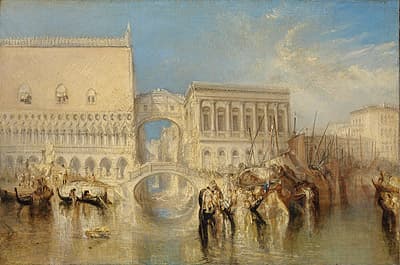
J M W
TURNER
Great Britain
1775
–
1851
68.6 (h) x 91.4 (w) cm Tate Accepted by the nation as part of the Turner Bequest 1856 Photo: © Tate 2013
‘No one,’ it is said, ‘enters Venice a stranger.’ The city’s spectacular topography has attracted countless artists over the centuries. But in addition to its visual appeal, Turner found in Venice a fallen empire, by then occupied by the Austrians. Like contemporaries such as Lord Byron, he saw parallels between the history and imperial ambitions of the Serene Republic and modern London.
Turner renders one of the most famous Venetian landmarks, the Bridge of Sighs, which connects the Doge’s Palace on the left with the prisons of the Palazzo dei Prigioni at right. Byron is also linked to this subject: supposedly it was he who coined the name of the bridge, deriving its title from the mournful image of convicts taking their last glimpse of the city before being led to the darkness of the cells below.
‘No one,’ it is said, ‘enters Venice a stranger.’ The city’s spectacular topography has attracted countless artists over the centuries. But in addition to its visual appeal, Turner found in Venice a fallen empire, by then occupied by the Austrians. Like contemporaries such as Lord Byron, he saw parallels between the history and imperial ambitions of the Serene Republic and modern London.
Turner renders one of the most famous Venetian landmarks, the Bridge of Sighs, which connects the Doge’s Palace on the left with the prisons of the Palazzo dei Prigioni at right. Byron is also linked to this subject: supposedly it was he who coined the name of the bridge, deriving its title from the mournful image of convicts taking their last glimpse of the city before being led to the darkness of the cells below.
‘No one,’ it is said, ‘enters Venice a stranger.’ The city’s spectacular topography has attracted countless artists over the centuries. But in addition to its visual appeal, Turner found in Venice a fallen empire, by then occupied by the Austrians. Like contemporaries such as Lord Byron, he saw parallels between the history and imperial ambitions of the Serene Republic and modern London.
Turner renders one of the most famous Venetian landmarks, the Bridge of Sighs, which connects the Doge’s Palace on the left with the prisons of the Palazzo dei Prigioni at right. Byron is also linked to this subject: supposedly it was he who coined the name of the bridge, deriving its title from the mournful image of convicts taking their last glimpse of the city before being led to the darkness of the cells below.

